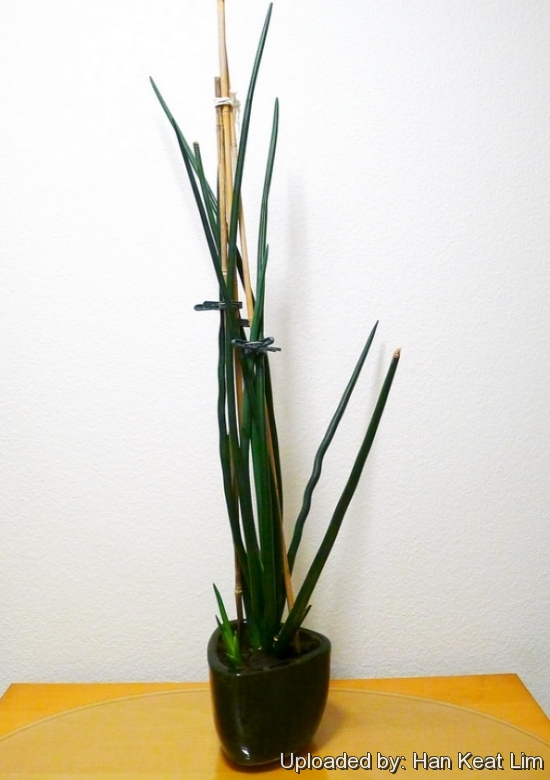




Your support is critical to our success.
Boll. Stud. Inform. Reale Giardino Colon. 4: 170 (1918)
Family: DRACAENACEAE

Origin and Habitat: Erithrea, and Ethiopia, north-eastern Africa. It probably also occurs in the Sudan.
Altitude range: 1200-2100 meters above sea level.
Habitat and ecology: Sansevieria erythraeaeSN|32201]]SN|32201]] grows in patches in semi-desert areas along the rivers.
Synonyms:
- Sansevieria erythraeae Mattei
- Sansevieria schweinfurthii Täckh. & Drar
ENGLISH: Pencil Sansevieria
Description: Sansevieria erythraeae (Pencil Sansevieria) is a stemless rhizomatous succulent, growing in patches. It is similar to Sansevieria cylindricaSN|32202]]SN|15713]], but with leaves more numerous, significantly longer, round and upright, like a pencil. The leaves are dark green, smooth, has no cross-banding but does have some longitudinal lines that are raised. Delicately scented flowers in a tight panicles are produced in spring and early summer, and it is said that this plant is sometimes grown for its ability to purify the air with the scent of its flowers. The synonym, Sansevieria schweinfurthiiSN|15713]]SN|32202]], is often used for this plant in cultivation. It differs from the related species, Sansevieria fischeri, in having 6–8 leaves. In contrast, S. fischeri has solitary leaves.
Derivation of specific name: The specific epithet as described in 1918 by Giovanni Ettore Mattei (1865-1943) comes from the Ancient Greek Eruthrá as the name for Eritrea and the area around the Red Sea.
Leaves: Numerous (mostly 6 to 8) from the base of the stem irregularly arranged in an open fan shaped, distichous rosette. Cylindrical, round in cross-section, about 40-90 cm long and 1.5 cm in diameter, green, erect or more or less spreading. The leaf tapper gradually to a rather stiff tip 2-3 mm long, with narrow longitudinal channels that also create 5 slightly raised ridges but otherwise are smooth to the touch
Inflorescence (raceme). Flower stalk, leafy, dense, as tall as the leaves (50-70 cm tall) densely covered with 3-5 flowers per cluster. Bract membranaceous, oval-lanceolate, and sharp.
Flowers: White, delicately scented. Pedicel 7-8 mm long, slender. Flower tube 5-7 mm long. Lobes linear, revolute, subobtuse, larger than 7 mm. Abundant and sticky nectar forms beads at the base of the flowers.
Blooming season: Flowering occurs in spring and early summer.
Notes: The genus Sansevieria numbers about 60 species most of them native of Africa, it has been variously included in the Amaryllidaceae, the Liliaceae and the Agavaceae but is nowadays usually placed in the Dracaenaceae.
Bibliography: Major references and further lectures
1) Urs Eggli, Leonard E. Newton “Etymological Dictionary of Succulent Plant Names” Springer Science & Business Media, 29 June 2013
2) Urs Eggli “Illustrated Handbook of Succulent Plants: Monocotyledons” Springer Science & Business Media, 06 December 2012
3) Adrian Pawitra “Sansevieria, 200 Jenis Spektakuler, 400 Foto.”, Trubus, Jawa Barat 2007
4) San Marcos Growers contributors “Sansevieria erythraeae - Pencil Sansevieria ” San Marcos Growers <http://www.smgrowers.com>. Web. 02 January 2016.
5) Peter A. Mansfeld: “Die Gattung Sansevieria – Alle Arten und ihre Pflege” BoD, Hamburg 2013
6) Demissew, S. & Nordal, I. “Aloes and other Lilies of Ethiopia and Eritrea”, ed, 2: 1-351. Shama Books, Addis Ababa, Ethiopia. 2010
7) Edwards, S., Demissew, S. & Hedberg, I. (eds.) “Flora of Ethiopia and Eritrea” 6: 1-586. 1997. The National Herbarium, Addis Ababa University, Ethiopia & The Department of Systematic Botany, Upps.
8) African Plants Database (version 3.4.0). Conservatoire et Jardin botaniques de la Ville de Genève and South African National Biodiversity Institute, Pretoria, "Retrieved 02 January 2016", from <http://www.ville-ge.ch/musinfo/bd/cjb/africa/>.
9) J.-P. LEBRUN & A. L. STORK (1991-2012). “Enumération des plantes à fleurs d'Afrique tropicale et Tropical African Flowering Plants: Ecology and Distribution”, vol. 1-7. Conservatoire et Jardin botaniques de la Ville de Genève.
10) Brink, M. & Achigan-Dako, E.G. “Fibres” PROTA, 2012
Cultivation and Propagation: Sansevieria erythraeaeSN|32201]]SN|32201]] is easy, but very slow-growing and tolerates a wide range of conditions. A great container plant that needs little care.
Soil: Use a soil mix consisting of 3 parts loam to 1 part of pumice.
Moisture requirements: The plants are very drought tolerant and are watered about every other week during the growing season. During the winter months they are watered once a month. Water sparingly and not at all as temperatures dip in winter but can tolerate going months between watering.
Fertilization: They are fertilized once during the growing season with a balanced fertilizer.
Light requirements: Will tolerate low light levels but grows best and flowers if given bright light and even tolerates full sun. In the garden In mild to tropical climates it prefers semishade or shade and it is not fussy.
Hardness: Sansevieria erythraeaeSN|32201]]SN|32201]] is theoretically hardy to -2° C, particularly when dry - but it is best to avoid severe freezing temperatures. If growing outdoors in frost free areas keep in a covered patio or under an area where plants do not receive winter rainfall.
Heat Tolerance: Excellent.
Propagation: Sansevieria erythraeaeSN|32201]]SN|32201]] are propagated by cuttings or by divisions taken at any time. Cuttings should be at least 10 cm long and inserted in moist sand. A rhizome will emerge at the cut edge of the leaf.
| Your Actions | |
|---|---|
| Back to Sansevieria index | |
| Back to Dracaenaceae index | |
 |
Back to Succulents Encyclopedia index |
Privacy stantement - Terms and conditions - How to cite - About us - Feedback - Donate



